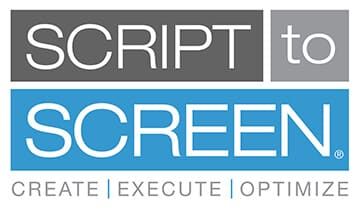With so many individuals and companies contacting us at Script to Screen to discuss the viability of DRTV for their respective product(s) or service(s), we find ourselves addressing many of the same questions, time and again.Which is great! We love talking DRTV, we do it all day every day, and we love answering any and all questions you may have. In fact, to that end we’ve put together a list of 20 Frequently Asked Questions About DRTV advertising. We’ll answer ten of the more fundamental questions this month, and then move on to ten more “advanced” questions next month.
1. What is DRTV?
Direct Response Television. Put simply, a TV ad that calls for a specific response from the viewer, and provides a clear, simple response path i.e.; a toll-free number or a website. This time-tested format (are you old enough to remember the Veg-O-Matic?) was originally used to market goods and services directly from the manufacturer or wholesaler to the consumer, bypassing retail. While that’s certainly still the way advertisers use the format, nowadays DRTV is also used to support retail sales (Shark/Ninja household appliances; Nescafe coffee makers) or drive leads (interested potential customers) to insurance companies (Progressive, Blue Shield); banks (Bank of America, Wells Fargo); cell phone providers (virtually all of them); credit card companies (Discover, Citibank); satellite TV (Dish Network, DirecTV), and a host of others.
2. What is an infomercial?
Also known as “long-form,” it’s a [28:30] (twenty-eight minutes, thirty seconds) TV commercial aimed at doing what all good DRTV does: drive response. Typically structured with three “CTA” (Call to Action) segments that function as “commercials within the commercial.” The longer format is typically a good fit for products or services that require detailed explanation (business opportunity; educational); demonstration (housewares; fitness equipment); before/after proof and expert support (health and beauty; diets; exercise programs); and/or are new to the marketplace and need time to tell their story. Also, if your product/service carries a relatively high price point, it’s important to have plenty of time to fully present your value proposition. Finally, all product/service categories can benefit from the additional time to include genuine, compelling testimonials.
3. What are the benefits of a DRTV infomercial?
DRTV is, arguably, the most accountable form of TV advertising. You can attribute every sale to a specific station, at a specific airtime, with a specific creative, at a specific cost, resulting in a complete and accurate understanding of your campaign’s cost-effectiveness. DRTV literally catches people where they live, captures their attention, and compels action while the viewer’s interest is at its peak. DRTV reinforces brand awareness and lifts revenues throughout all sales channels, just as a conventional ad might. But unlike a conventional ad, you’re able to measure exactly how much awareness you generated based on response and conversion rates.
Why an infomercial? As noted above, the key benefit is the amount of time available to present the full “story” of your product or service. Think of it as the difference between a two-line classified ad and a full-page spread in a magazine. The more you can tell, the more you can sell.
4. Who watches infomercials?
It’s safe to say that virtually everyone has seen all or part of an infomercial at some point in their lives. But the important question isn’t so much who watches them, but who buys from them. In an independent study, some interesting insights emerged. A few tidbits:
• Purchasers of infomercial products tend to exercise, enjoy movies, and follow sports.
• They tend to skew younger than those who don’t purchase from infomercials.
• They watch more than 12 hours of TV a week.
• They enjoy shopping from home (an increasing trend for all consumers).
• They embrace digital technology, usually using a mobile device as they watch TV.
5. Do infomercials work? Do people really buy in the middle of the night?
In a word, absolutely. That’s why DRTV in general, and infomercials specifically, have experienced so much success over the past thirty years, and why an ever increasing number of big brands make direct response television an important component of their advertising strategies. It’s also why companies with a strong retail presence look to DRTV to exponentially grow their business and reduce their dependence on retail, as in this case for a current Script to Screen DRTV agency client, Lifes2good/Viviscal. And not only do people buy in the middle of the night, they buy whenever the infomercial is on. According to a recent study, in fact, about 75% of infomercial customers make their purchase during the show or within a few hours after it aired—no matter what time it aired! Of course, due to the pinpoint “trackability” of DRTV airings, you’ll be able to determine the time of day your infomercial performs the best, and focus your airings accordingly.
6. Who should use DRTV infomercials?
Anyone with a product or service who wants to:
• Acquire more customers
• Move into retail or boost retail sales
• Exponentially expand their reach beyond retail
• Optimize their advertising ROI
• Clearly differentiate themselves from the competition
• Sell across multiple channels
• Lift sales in all channels
• Drive website traffic
• Generate more leads
In other words, just about any purveyor of a product or service can benefit from DRTV. And if your product or service falls into any of the categories mentioned in #2 above, a long-form infomercial format may be your best strategy to achieve your goals.
7. How long does it take to produce a DRTV infomercial?
Generally speaking (very generally!) long-form infomercial production is a 3-4 month process, from initial concept to final edit. That said, there are a plethora of variables that can extend (or, in some cases, contract) that production time. Example: you’ve got a new diet product. In order to get before/after results and testimonials, several weeks of user trials would have to be conducted and documented. While certain elements of the infomercial could be produced in the meantime, you could be looking at a timeframe of six months to achieve the results you want to feature in the show.
8. How much does a DRTV infomercial cost?
This is a common question, but there’s no specific answer. It’s very much like asking, “How much does a car cost?” Your answer would be, “Well, that depends on what kind of car you want, and will meet your needs.” Same answer when it comes to infomercials. Speaking very generally again, most of the effective, long-running infomercials you see on the air are in the $350,000-$600,000 range. Certainly the “low-end” producers can provide a commensurately low-end production for less. While results are not always directly related to the amount of money spent on production, there are some intangibles such as brand image and perception of quality that need to be factored in when talking production budget.
9. What is a MER?
Media Efficiency Ratio (MER): The number that provides a snapshot of the success level of a media buy. The ratio is derived by dividing total sales (resulting from a particular telecast) by the media cost. For example, if you buy a half-hour for $1,000 and generate $3,000 in sales, the MER is 3.0. Sales/Media cost = MER.
10. How do you measure the success of a DRTV infomercial?
There’s the obvious answer of course: If the MER is strong enough to show your revenues exceed all of your costs (including the costs of goods and fulfillment), it’s a winner. However, there are actually many successful infomercials where the MER is less than breakeven, for instance, fitness and consumable products (beauty, weight loss, subscriptions, insurance, etc.). In these cases the goal is customer acquisition, because the lifetime value of a customer is so significant. Examples of products that employ this strategy are Proactive or P90X. Also, an infomercial for a product offered at retail could actually be losing money on the “front end,” but closer analysis would show a significant bump in retail or online sales (or both) that makes airing an infomercial the most effective and least expensive form of advertising. An example of a company that excels in using this strategy is Shark/Ninja.
Next month: We answer ten more Frequently Asked Questions about Direct Response Television and long-form infomercials.

